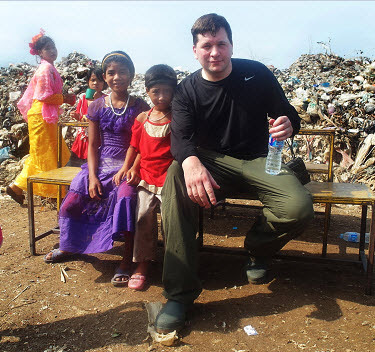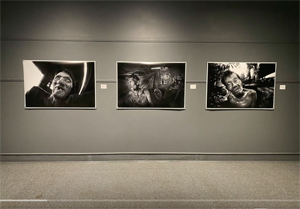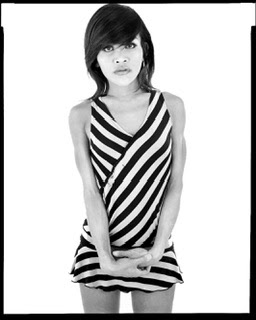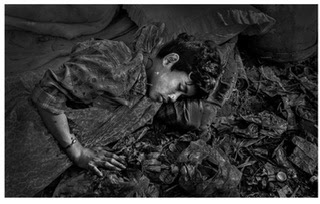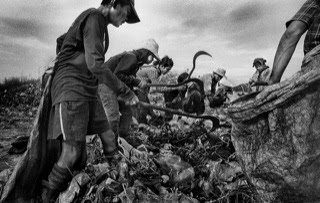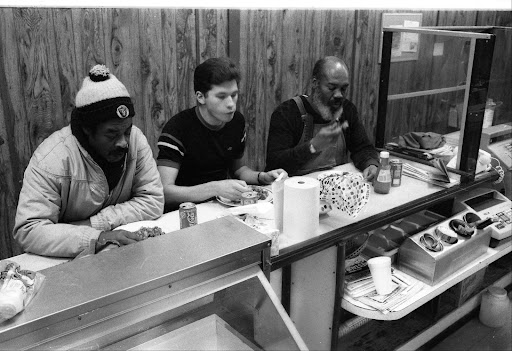With my cat laying next to me (lovely warm animal, she always likes to make physical contact) I am working on a very early draft of the video I intend to put into the "Living on the Margins" Exhibition. Yes that is the official title, which I think is fitting for both Larry's and my work.
Anyway back to my thought, I am working on my part of the video for the show. The idea is to do 2 videos back to back first Larry (shot by Larry's wife Joanna) and then of me (shot by me). I plan on my video starting out with my first day at the dump and some of my early experiences.
The idea is to have a video presentation upstairs along with the photographs. I think its important to keep things short and fluid so it flows nicely. The whole thing most likely will only run 10-15 minutes and be on a continuous loop. I am including a soundtrack but likely the sound will probably be turned off.
Here is the first part of my section of the video, it is rather rough and will be reworked many times. I thought thou you might like to have a very early taste. The beginning of this video are my first moments in the dump in May 2013 as explained in the artist statement blog story.
Here is the longer version of the artist statement I might use. I am trying to make it personal and not so arty farty arrogant. I think people respond better when the feelings expressed are more down home, straight forward and honest. Visitors sometimes get intimidated by the whole arty, snobby art superiority culture crap. I want my work and statements to be down home, straight forward, accessible and understandable for the average person. To put it in simpler terms I never want my artist statements to be about my egotistical artistic pretensions. I want my artist statements to instead be about my subjects, their lives and stories are what matters, not Mr. Gerry.
I will trim this LONG blog down to a more manageable standing and reading in a gallery level for the show. I want to keep the essence of what I wrote but will shorten it. I can save this longer version for the high quality personalized book : ))
http://www.gerryyaum.blogspot.ca/2014/09/children-of-dump-artist-statement-why-i.html
Anyway back to my thought, I am working on my part of the video for the show. The idea is to do 2 videos back to back first Larry (shot by Larry's wife Joanna) and then of me (shot by me). I plan on my video starting out with my first day at the dump and some of my early experiences.
The idea is to have a video presentation upstairs along with the photographs. I think its important to keep things short and fluid so it flows nicely. The whole thing most likely will only run 10-15 minutes and be on a continuous loop. I am including a soundtrack but likely the sound will probably be turned off.
Here is the first part of my section of the video, it is rather rough and will be reworked many times. I thought thou you might like to have a very early taste. The beginning of this video are my first moments in the dump in May 2013 as explained in the artist statement blog story.
I will trim this LONG blog down to a more manageable standing and reading in a gallery level for the show. I want to keep the essence of what I wrote but will shorten it. I can save this longer version for the high quality personalized book : ))
http://www.gerryyaum.blogspot.ca/2014/09/children-of-dump-artist-statement-why-i.html
"Children of the Dump" Artist Statement, Why I Made The Photos
The "Families of the Dump" and this smaller "Children of the Dump" documentary photograph series was made at the Mae Sot Thailand garbage dump where around 400 people in 50 plus families live and work. The families are made up of Burmese refugees mostly from the Karen ethnic group, they illegally travelled from Burma into Thailand to scavenge and work in the Mae Sot dump digging for recyclable goods. All able bodied members of the family work, from the very young to the very old. There is a school nearby for the children but often they are required to work and cannot go to school.
Why make the photographs for the "Children of the Dump" series? It all came down to that first day I visited the dump, that first day, what I saw, the experiences I had locked me into this project. Here is a rather long winded story about that day and a bit of what happened before and after.
My first day at the dump was in May of 2013, I was unsure what to expect. Over the years and 11 previous trips I had become fairly comfortable in Thailand, I could speak some of the language I could even read and write a bit in Thai but this was something new, something different. I was worried and a bit apprehensive about how this all would play out. The dump was populated not by Thais but by Burmese, people who were refugees, illegals inside Thailand who were escaping political persecution and or economic hardships in their own country of Burma. My knowledge of the Thai language and experiences photographing Thais in the slums of Bangkok or the beer bars of Pattaya would be of little value.
To get to the dump I first had to fly from Canada, 3 airplanes and 24 hours later I was in my hotel in Bangkok. I then arranged a bus ticket for the overnight 10 hour trip from Bangkok to Mae Sot Thailand. Mae Sot is a town that is 70% Burmese even thou it is inside Thailand, it snuggles up along the Moei river which separates Thailand and Burma. Burmese workers can easily cross the Moei river to work inside Thailand legally or illegally. There is a lot of human, drug and gem smuggling along this border area and a corresponding large police and military presence.
On arrival in Mae Sot I was spent, exhausted and still recovering from jet lag. I checked into my second hotel and went in search of food. I had no idea how to get to the dump or exactly what I would find but I figured I would ask a motorcycle taxi driver. The one thing you can always be sure of no matter where you visit is that taxi drivers know where stuff is. My Thai language skills came in handy as I was able to communicate my intentions and to arrange for a pickup early next morning. The deal was that the driver would pick me up at my hotel and take me out to dump at 8am for 60baht ($2.00 CAD).
The next morning after a rough night’s sleep I was up at 715am, had a quick shower, a jam sandwich and some water. After putting on a ton of sunblock and gathering up my photo gear I was ready to go. I met Khune Noi (the driver) out in front of my $20 a night hotel and off we went me on the back of the motorbike him driving. We drove through the dark streets passing the occasional orange robed Buddhist monk or groups of monks walking barefoot in search of their morning alms (collecting donated food). After about 30 minutes of winding, dusty, bumpy, pot holed roads, we approached the dump entrance. We wound around a green water lake, I could smell the garbage and see the small shacked family homes in the distance. It took another slow 5 minutes of driving and finally we arrived, Khune Noi stopped the bike I clamored off and readjusted my cameras. He then handed me the bag I had given him earlier. The bag contained some rice, canned fish and soap. My plan was that every day I came to the dump I would give out a gift bag to one of the families. I asked Khune Noi to return at 12 noon to take me home, he smiled and left.
So there I was standing on the road next to the green lake in the early morning light. The numerous bamboo-wood-plastic covered huts extended down the road on my left, there must have been 15 or more with the lake on my right. Some of the families peered out at me others went on with their morning chores showing little concern. I went up to the first house and gave the bag of rice to the lady sitting in the entrance. I did my best to say "rice"in Burmese as I handed it to her, she smiled waied me (put her hands together as if in prayer) and said thank you in Burmese.
Now that I had gotten rid of the extra baggage I wanted to make some pictures. I started to wander slowly, the sun had risen and it was already becoming quite hot. I tried to be as polite and unobtrusive as I could, approaching the homes and quietly taking a few photographs. When people would look at me, I would hold up the camera asking if it was OK to photograph. Sometimes I just smiled and said "minga lah bah" hello in Burmese. When I was done I would say "zah zue din bah day" thank you. After 45-60 minutes of this wandering I came across a young boy holding a sickle like tool that was used for digging in the dump. I shot some photographs of him and then he turned and headed towards the nearby dump, he walked quickly down a small path. I made several photos of him as he walked in front of me, he got farther and farther ahead as I struggled through the mounting garbage. He soon was out of range of my camera.

Young boy walking into the dump my first day shooting, May 2013
I looked for another subject, off in the distance maybe 300 meters ahead I saw a figure with a white hat working. By this time it was quite hot, the sunlight was very bright and reflected off all the white bags on the ground, all that light being bounced back up into my face made it hard on the eyes. I decided to head to the worker with the hat and see what that would yield. I started off, often my feet sank deep into the garbage, I tried to avoid the more smelly messy areas, there were hills and hills of waste, far into the horizon. As I walked the flies came, I had never seen or experienced so many flies before. They were all over me, on my hands, arms, face, nose, eyes, ears, they moved on my fingers, on my camera and on my lens. I continued to walk, there was no wind, the flies buzzed my ears, crawled on my face, the smell of the rotting garbage grew stronger, the now incredible heat got worse. All I could think about was these blasted flies. I started to get very uncomfortable, sweat ran down my face into my eyes, the sunblock stung my eyes, the flies continued buzzing and crawling all over me. They climbed everywhere, first on the garbage, then on me, if I breathed through my mouth they would fly inside my mouth and I had to spit them out. This all seemed crazy! Why was I here? Why was I doing this? These bloody disgusting flies! I counted them, there were now 40 walking or sitting on the parts of my body that I could see. I started to freak out a bit, started to feel more and more disturbed by it all. There was nowhere to go, I was trapped, damn it was so hot! Finally I reached the figure with the white hat.
I looked at the worker, it was a man, no a woman, no not a woman it was a girl, a young girl, maybe 11 years old, I found out later her name was Doo-Aye. She looked at me with interest and curiosity as children do and smiled. I stopped and photographed her, her father was nearby but was involved in his own scavenging and paid me no mind. Doo-Aye had on the simple white hat I had seen earlier and had thanaka on her face. Thanaka is a white paste made from tree bark, the Burmese wear it as a sunscreen and also as a cosmetic for beauty. She worked and dug in the garbage alongside her father, they were filling up a big bag with anything worth salvaging, mostly plastics and cardboard. Then Doo-Aye found a ladies purse, something some Thai women in Mae Sot had thrown away. She looked through every part of it hoping to find anything of value, she searched all the corners, all the compartments pulling stuff out and letting it fall on the ground. I continued to photograph her and made a short video with my digital camera as she worked. Every now and then she looked up at me with curiosity and smiled. I asked myself "Why was this child working like this?"
Doo-Aye was the key to my wanting to do this series of photographs in the dump. She was the reason I wanted to tell the story of these forgotten families and these poverty stricken children. Once I saw her eyes, the friendliness of her smile and the quiet acceptance of the hard ugly work she was doing, I was hooked. She had a grace, a vulnerability, a joy for life to her that seemed so contradictory to the circumstances she lived in. This little girl should have been in school with opportunities for a greater future, instead she was here in this garbage, in this heat, with these bloody flies. Seeing her woke me up, here was this child, an 11 year old person living this way and trying to help her family. What the f-ck was I whining about? What were a few flies, a little bit of short time discomfort compared to Doo-Aye's past, present and future lives. I had to make pictures here, I had to tell others what I saw, I had to try to educate and inform through the photographs and my blog.

Doo-Aye surrounded by garbage, my first day in the dump May 2013
After that first day I was hooked, I went every day for the next week making pictures from 7am till 12 noon, I even got used to those blasted disgusting flies. I met other hard working families, who allowed me to photograph them and showed me their children with pride. Some of the women from the families got on me for not wearing a hat, they motioned up at the the sun, said the word "hot" in Burmese then pointed at their hat and my bare head. They shook their heads at me and frowned. This happened numerous times, it was sort of like having a Burmese mother or sister, someone watching over me. The more time I spend in the dump the more I became involved in the lives of the individuals.These people were living in absolute poverty but they had a beautiful dignity to them. I had shot photos for 8 days in a row, I made photographs until I ran out of film. Now I had to leave, it was time to return to Bangkok and then Canada, security work awaited (I work as a security guard).
In November of 2013 I returned to Mae Sot to make photos for another 6 days. My first morning back there were shouts of "Minga Lah Bah!!!" directed at me from 5 or 6 different people, it was a happy return, I felt part of a family. I wore a hat this time round and one of the men looked at me, pointed at my hat then gave me a thumbs up and a big smile. This second trip I made pictures and gave them as gifts, I started donating more and more food bags, some mornings carrying 3 heavy bags in along with all my photo gear. I eventually donated money to the local Burmese school, a school where the teachers worked as volunteers. The little bit I gave was not much for me but so important to the lives of the people living in the dump. Being part of those lives for a short time enriched me in so many different ways. It is hard to describe my feeling about the dump, in one sense it’s a terrible place but because of the people it is also sometimes beautiful.
As I left Mae Sot and the "Families of the Dump" for a second time I thought about our different lives, the differences fate had bestowed on us. I could run away from the dump, my Canadian passport and money meant I could leave and return to my privileged life in Canada. The families working the dump could not leave, they had nowhere to go and little hope of a brighter future. Now today as I write these words in my comfortable clean guard shack on my nice new computer Doo-Aye continues to live and work in the dump with the flies, cockroaches and rats. What will her future be? Will she find happiness? A loving husband? Children of her own? Will her children be allowed a better life?
I am unable to return to the Mae Sot in 2014 but I will return in 2015. I will go back to continue photographing Doo-Aye her family and the other "Families of the Dump", their stories need to be told.
The attached link is to the "Eyes to Burma" charity, it is run by Mr. Fred Stockwell, he does good work helping the Burmese families living in the Mae Sot garbage dump. If you can please make a donation to his organization.
Thanks Gerry
http://eyestoburma.org/
The "Families of the Dump" and this smaller "Children of the Dump" documentary photograph series was made at the Mae Sot Thailand garbage dump where around 400 people in 50 plus families live and work. The families are made up of Burmese refugees mostly from the Karen ethnic group, they illegally travelled from Burma into Thailand to scavenge and work in the Mae Sot dump digging for recyclable goods. All able bodied members of the family work, from the very young to the very old. There is a school nearby for the children but often they are required to work and cannot go to school.
Why make the photographs for the "Children of the Dump" series? It all came down to that first day I visited the dump, that first day, what I saw, the experiences I had locked me into this project. Here is a rather long winded story about that day and a bit of what happened before and after.
My first day at the dump was in May of 2013, I was unsure what to expect. Over the years and 11 previous trips I had become fairly comfortable in Thailand, I could speak some of the language I could even read and write a bit in Thai but this was something new, something different. I was worried and a bit apprehensive about how this all would play out. The dump was populated not by Thais but by Burmese, people who were refugees, illegals inside Thailand who were escaping political persecution and or economic hardships in their own country of Burma. My knowledge of the Thai language and experiences photographing Thais in the slums of Bangkok or the beer bars of Pattaya would be of little value.
To get to the dump I first had to fly from Canada, 3 airplanes and 24 hours later I was in my hotel in Bangkok. I then arranged a bus ticket for the overnight 10 hour trip from Bangkok to Mae Sot Thailand. Mae Sot is a town that is 70% Burmese even thou it is inside Thailand, it snuggles up along the Moei river which separates Thailand and Burma. Burmese workers can easily cross the Moei river to work inside Thailand legally or illegally. There is a lot of human, drug and gem smuggling along this border area and a corresponding large police and military presence.
On arrival in Mae Sot I was spent, exhausted and still recovering from jet lag. I checked into my second hotel and went in search of food. I had no idea how to get to the dump or exactly what I would find but I figured I would ask a motorcycle taxi driver. The one thing you can always be sure of no matter where you visit is that taxi drivers know where stuff is. My Thai language skills came in handy as I was able to communicate my intentions and to arrange for a pickup early next morning. The deal was that the driver would pick me up at my hotel and take me out to dump at 8am for 60baht ($2.00 CAD).
The next morning after a rough night’s sleep I was up at 715am, had a quick shower, a jam sandwich and some water. After putting on a ton of sunblock and gathering up my photo gear I was ready to go. I met Khune Noi (the driver) out in front of my $20 a night hotel and off we went me on the back of the motorbike him driving. We drove through the dark streets passing the occasional orange robed Buddhist monk or groups of monks walking barefoot in search of their morning alms (collecting donated food). After about 30 minutes of winding, dusty, bumpy, pot holed roads, we approached the dump entrance. We wound around a green water lake, I could smell the garbage and see the small shacked family homes in the distance. It took another slow 5 minutes of driving and finally we arrived, Khune Noi stopped the bike I clamored off and readjusted my cameras. He then handed me the bag I had given him earlier. The bag contained some rice, canned fish and soap. My plan was that every day I came to the dump I would give out a gift bag to one of the families. I asked Khune Noi to return at 12 noon to take me home, he smiled and left.
So there I was standing on the road next to the green lake in the early morning light. The numerous bamboo-wood-plastic covered huts extended down the road on my left, there must have been 15 or more with the lake on my right. Some of the families peered out at me others went on with their morning chores showing little concern. I went up to the first house and gave the bag of rice to the lady sitting in the entrance. I did my best to say "rice"in Burmese as I handed it to her, she smiled waied me (put her hands together as if in prayer) and said thank you in Burmese.
Now that I had gotten rid of the extra baggage I wanted to make some pictures. I started to wander slowly, the sun had risen and it was already becoming quite hot. I tried to be as polite and unobtrusive as I could, approaching the homes and quietly taking a few photographs. When people would look at me, I would hold up the camera asking if it was OK to photograph. Sometimes I just smiled and said "minga lah bah" hello in Burmese. When I was done I would say "zah zue din bah day" thank you. After 45-60 minutes of this wandering I came across a young boy holding a sickle like tool that was used for digging in the dump. I shot some photographs of him and then he turned and headed towards the nearby dump, he walked quickly down a small path. I made several photos of him as he walked in front of me, he got farther and farther ahead as I struggled through the mounting garbage. He soon was out of range of my camera.
Why make the photographs for the "Children of the Dump" series? It all came down to that first day I visited the dump, that first day, what I saw, the experiences I had locked me into this project. Here is a rather long winded story about that day and a bit of what happened before and after.
My first day at the dump was in May of 2013, I was unsure what to expect. Over the years and 11 previous trips I had become fairly comfortable in Thailand, I could speak some of the language I could even read and write a bit in Thai but this was something new, something different. I was worried and a bit apprehensive about how this all would play out. The dump was populated not by Thais but by Burmese, people who were refugees, illegals inside Thailand who were escaping political persecution and or economic hardships in their own country of Burma. My knowledge of the Thai language and experiences photographing Thais in the slums of Bangkok or the beer bars of Pattaya would be of little value.
To get to the dump I first had to fly from Canada, 3 airplanes and 24 hours later I was in my hotel in Bangkok. I then arranged a bus ticket for the overnight 10 hour trip from Bangkok to Mae Sot Thailand. Mae Sot is a town that is 70% Burmese even thou it is inside Thailand, it snuggles up along the Moei river which separates Thailand and Burma. Burmese workers can easily cross the Moei river to work inside Thailand legally or illegally. There is a lot of human, drug and gem smuggling along this border area and a corresponding large police and military presence.
On arrival in Mae Sot I was spent, exhausted and still recovering from jet lag. I checked into my second hotel and went in search of food. I had no idea how to get to the dump or exactly what I would find but I figured I would ask a motorcycle taxi driver. The one thing you can always be sure of no matter where you visit is that taxi drivers know where stuff is. My Thai language skills came in handy as I was able to communicate my intentions and to arrange for a pickup early next morning. The deal was that the driver would pick me up at my hotel and take me out to dump at 8am for 60baht ($2.00 CAD).
The next morning after a rough night’s sleep I was up at 715am, had a quick shower, a jam sandwich and some water. After putting on a ton of sunblock and gathering up my photo gear I was ready to go. I met Khune Noi (the driver) out in front of my $20 a night hotel and off we went me on the back of the motorbike him driving. We drove through the dark streets passing the occasional orange robed Buddhist monk or groups of monks walking barefoot in search of their morning alms (collecting donated food). After about 30 minutes of winding, dusty, bumpy, pot holed roads, we approached the dump entrance. We wound around a green water lake, I could smell the garbage and see the small shacked family homes in the distance. It took another slow 5 minutes of driving and finally we arrived, Khune Noi stopped the bike I clamored off and readjusted my cameras. He then handed me the bag I had given him earlier. The bag contained some rice, canned fish and soap. My plan was that every day I came to the dump I would give out a gift bag to one of the families. I asked Khune Noi to return at 12 noon to take me home, he smiled and left.
So there I was standing on the road next to the green lake in the early morning light. The numerous bamboo-wood-plastic covered huts extended down the road on my left, there must have been 15 or more with the lake on my right. Some of the families peered out at me others went on with their morning chores showing little concern. I went up to the first house and gave the bag of rice to the lady sitting in the entrance. I did my best to say "rice"in Burmese as I handed it to her, she smiled waied me (put her hands together as if in prayer) and said thank you in Burmese.
Now that I had gotten rid of the extra baggage I wanted to make some pictures. I started to wander slowly, the sun had risen and it was already becoming quite hot. I tried to be as polite and unobtrusive as I could, approaching the homes and quietly taking a few photographs. When people would look at me, I would hold up the camera asking if it was OK to photograph. Sometimes I just smiled and said "minga lah bah" hello in Burmese. When I was done I would say "zah zue din bah day" thank you. After 45-60 minutes of this wandering I came across a young boy holding a sickle like tool that was used for digging in the dump. I shot some photographs of him and then he turned and headed towards the nearby dump, he walked quickly down a small path. I made several photos of him as he walked in front of me, he got farther and farther ahead as I struggled through the mounting garbage. He soon was out of range of my camera.
 |
| Young boy walking into the dump my first day shooting, May 2013 |
I looked for another subject, off in the distance maybe 300 meters ahead I saw a figure with a white hat working. By this time it was quite hot, the sunlight was very bright and reflected off all the white bags on the ground, all that light being bounced back up into my face made it hard on the eyes. I decided to head to the worker with the hat and see what that would yield. I started off, often my feet sank deep into the garbage, I tried to avoid the more smelly messy areas, there were hills and hills of waste, far into the horizon. As I walked the flies came, I had never seen or experienced so many flies before. They were all over me, on my hands, arms, face, nose, eyes, ears, they moved on my fingers, on my camera and on my lens. I continued to walk, there was no wind, the flies buzzed my ears, crawled on my face, the smell of the rotting garbage grew stronger, the now incredible heat got worse. All I could think about was these blasted flies. I started to get very uncomfortable, sweat ran down my face into my eyes, the sunblock stung my eyes, the flies continued buzzing and crawling all over me. They climbed everywhere, first on the garbage, then on me, if I breathed through my mouth they would fly inside my mouth and I had to spit them out. This all seemed crazy! Why was I here? Why was I doing this? These bloody disgusting flies! I counted them, there were now 40 walking or sitting on the parts of my body that I could see. I started to freak out a bit, started to feel more and more disturbed by it all. There was nowhere to go, I was trapped, damn it was so hot! Finally I reached the figure with the white hat.
I looked at the worker, it was a man, no a woman, no not a woman it was a girl, a young girl, maybe 11 years old, I found out later her name was Doo-Aye. She looked at me with interest and curiosity as children do and smiled. I stopped and photographed her, her father was nearby but was involved in his own scavenging and paid me no mind. Doo-Aye had on the simple white hat I had seen earlier and had thanaka on her face. Thanaka is a white paste made from tree bark, the Burmese wear it as a sunscreen and also as a cosmetic for beauty. She worked and dug in the garbage alongside her father, they were filling up a big bag with anything worth salvaging, mostly plastics and cardboard. Then Doo-Aye found a ladies purse, something some Thai women in Mae Sot had thrown away. She looked through every part of it hoping to find anything of value, she searched all the corners, all the compartments pulling stuff out and letting it fall on the ground. I continued to photograph her and made a short video with my digital camera as she worked. Every now and then she looked up at me with curiosity and smiled. I asked myself "Why was this child working like this?" Doo-Aye was the key to my wanting to do this series of photographs in the dump. She was the reason I wanted to tell the story of these forgotten families and these poverty stricken children. Once I saw her eyes, the friendliness of her smile and the quiet acceptance of the hard ugly work she was doing, I was hooked. She had a grace, a vulnerability, a joy for life to her that seemed so contradictory to the circumstances she lived in. This little girl should have been in school with opportunities for a greater future, instead she was here in this garbage, in this heat, with these bloody flies. Seeing her woke me up, here was this child, an 11 year old person living this way and trying to help her family. What the f-ck was I whining about? What were a few flies, a little bit of short time discomfort compared to Doo-Aye's past, present and future lives. I had to make pictures here, I had to tell others what I saw, I had to try to educate and inform through the photographs and my blog.
In November of 2013 I returned to Mae Sot to make photos for another 6 days. My first morning back there were shouts of "Minga Lah Bah!!!" directed at me from 5 or 6 different people, it was a happy return, I felt part of a family. I wore a hat this time round and one of the men looked at me, pointed at my hat then gave me a thumbs up and a big smile. This second trip I made pictures and gave them as gifts, I started donating more and more food bags, some mornings carrying 3 heavy bags in along with all my photo gear. I eventually donated money to the local Burmese school, a school where the teachers worked as volunteers. The little bit I gave was not much for me but so important to the lives of the people living in the dump. Being part of those lives for a short time enriched me in so many different ways. It is hard to describe my feeling about the dump, in one sense it’s a terrible place but because of the people it is also sometimes beautiful. As I left Mae Sot and the "Families of the Dump" for a second time I thought about our different lives, the differences fate had bestowed on us. I could run away from the dump, my Canadian passport and money meant I could leave and return to my privileged life in Canada. The families working the dump could not leave, they had nowhere to go and little hope of a brighter future. Now today as I write these words in my comfortable clean guard shack on my nice new computer Doo-Aye continues to live and work in the dump with the flies, cockroaches and rats. What will her future be? Will she find happiness? A loving husband? Children of her own? Will her children be allowed a better life? I am unable to return to the Mae Sot in 2014 but I will return in 2015. I will go back to continue photographing Doo-Aye her family and the other "Families of the Dump", their stories need to be told. The attached link is to the "Eyes to Burma" charity, it is run by Mr. Fred Stockwell, he does good work helping the Burmese families living in the Mae Sot garbage dump. If you can please make a donation to his organization. Thanks Gerry http://eyestoburma.org/ | ||




